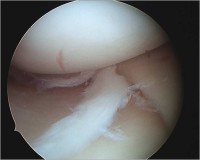
Knee arthroscopy is a common minimally invasive (keyhole) surgical procedure which is usually performed as a day surgery procedure. This involves putting a camera and instruments into the knee via very small skin incisions (typically 2) and treating identifiable problems. Arthroscopy gives doctors a clear view of the inside of the knee. A fairly quick recovery is expected given the minimally invasive nature of these operations. Technical advances have led to high definition monitors and high resolution cameras. These and other improvements have made knee arthroscopy a very effective tool for treating knee problems.
Knee Arthroscopy Procedure
The orthopaedic surgeon will make a few small incisions in your knee. A sterile solution will be used to fill the knee joint and rinse away any cloudy fluid. This helps your orthopaedic surgeon see your knee clearly and in great detail.

Your surgeon’s first task is to properly diagnose your problem. He or she will insert the arthroscope and use the image projected on the screen to guide it. If surgical treatment is needed, your surgeon will insert tiny instruments through another small incision. These instruments might be scissors, motorized shavers, or lasers.
This part of the knee arthroscopy procedure usually lasts 30 minutes to over an hour. How long it takes depends upon the findings and the treatment necessary.
Arthroscopy for the knee is most commonly used for:
- Removal or repair of a torn meniscus
- Reconstruction of a torn anterior cruciate ligament (ACL)
- Trimming of torn pieces of articular cartilage
- Removal of loose fragments of bone or cartilage
- Removal of inflamed synovial tissue
Your knee surgeon may close your incisions with a stitch or steri-strips (small bandaids) and cover them with a soft bandage.
You will be moved to the recovery room and should be able to go home within 2-4 hours. Be sure to have someone with you to drive you home.
Recovery from Knee Arthroscopy
Recovery from knee arthroscopy is much faster than recovery from traditional open knee surgery. Still, it is important to follow your orthopaedic surgeon’s instructions carefully after you return home.
Swelling
Keep your leg elevated as much as possible for the first few days after surgery. Apply ice as recommended by your doctor to relieve swelling and pain.

Dressing Care
You will leave the hospital with a dressing covering your knee. Keep your incisions clean and dry. Your surgeon will tell you when you can shower or bathe, and when you should change the dressing.
Your surgeon will see you in the office a few days after surgery to check your progress, review the surgical findings, and begin your postoperative treatment program.
Bearing Weight
Most patients need crutches or other assistance after arthroscopic surgery. Your surgeon will tell you when it is safe to put weight on your foot and leg. If you have any questions about bearing weight, call your foot surgeon.
Driving
Your doctor will discuss with you when you may drive. This decision is based on a number of factors, including:
- The knee involved
- Whether you drive an automatic or stick shift
- The nature of the procedure
- Your level of knee pain
- Whether you are using narcotic pain medications
- How well you can control your knee.
Typically, patients are able to drive from 1 to 3 weeks after the procedure.
Medication
Your doctor will prescribe pain medication to help relieve discomfort following your surgery. He or she may also recommend medication such as aspirin to lessen the risk of blood clots.
Exercises to Strengthen Your Knee
You should exercise your knee regularly for several weeks after surgery. This will restore motion and strengthen the muscles of your leg and knee. Therapeutic exercise will play an important role in how well you recover. A formal physical therapy program may improve your final result.
Complications and Warning Signs
As with any surgery, there are risks associated with knee arthroscopy. These occur infrequently and are minor and treatable.
Complications
Potential postoperative problems with knee arthroscopy include:
- Infection
- Blood clots
- Accumulation of blood in the knee
Warning Signs
Call your orthopaedic surgeon immediately if you experience any of the following:
- Fever
- Chills
- Persistent warmth or redness around the knee
- Persistent or increased knee pain
- Significant swelling in your knee
- Increasing pain in your calf muscle
Looking For A Reliable Knee Orthopaedic Specialist?
Fast Medical Attention, Transparent Fees
Make an appointment for comprehensive care for your knee problems!
